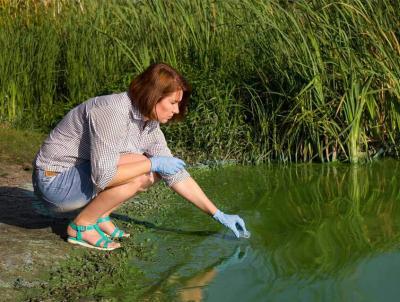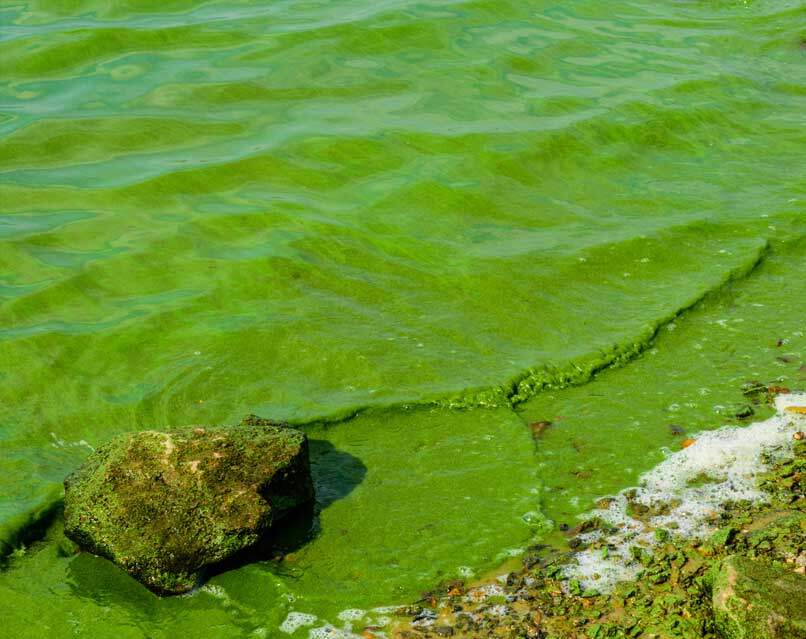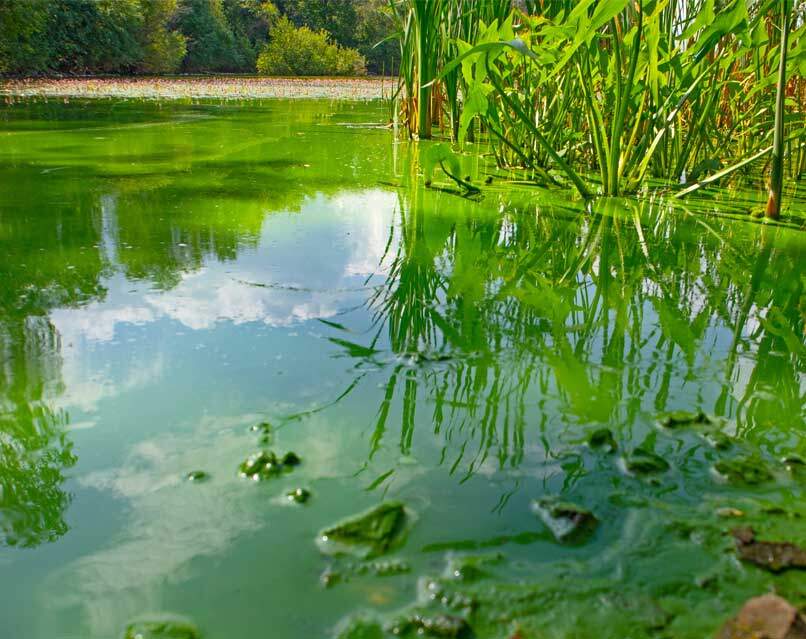Cyanobacteria also known as blue-green algae is a bacteria class that obtains its energy through a process known as photosynthesis. For this type of bacteria to grow there need to be certain environmental conditions. It can be found in any type of water (fresh, brackish, or marine). Typically, they are microscopic, but they can become visible in warm water that is nutrient-rich allowing them to quickly grow and “bloom” in bodies of water. They get their name because of their color, texture, and aquatic location, but they are not plants like typical algae.
 Dangers of Cyanobacteria Blooms
Dangers of Cyanobacteria Blooms
Cyanobacteria can bloom when the population of cyanobacteria explodes. This can happen in water that is still or slow-moving. Lakes, ponds, and weak streams are where it is typically found. When the water gets warm and there is plenty of sunlight along with water that has nutrients like phosphorous and nitrogen, blooms can occur.
Here in the United States, these blooms can occur in mid-summer to early fall, although they can occur any time of the year according to information by the Centers for Disease Control and Prevention (CDC). Most cyanobacteria species float in water and appear as foam, scum, or mats on the water’s surface.
Cyanobacteria blooms become dangerous. Cyanobacterial harmful algal blooms can use up the oxygen in the water and block sunlight that freshwater plants and animals require to live.
Some cyanobacteria can produce toxins called cyanotoxins. In the United States, the most common cyanotoxin-producing varieties are Microcystis, Anabaena, and Oscillatoria, which produce toxins in the microcystin, cylindrospermopsin, anatoxin, and saxitoxin classes, according to the Environmental Protection Agency (EPA).
How to Manage Algae Growth
To help control and minimize the growth of blue-green algae you need to reduce the source of excess nutrients. Some of the known sources that can be changed would include diverting water runoff, planting vegetation to create a buffer, limit the amount of lawn fertilizer used. You also want to keep organic matter away like dead leaves and vegetation as they can aid algae growth as they break down.
Pond maintenance helps to minimize the growth of algae and prevent cyanobacteria blooms from appearing. It is important to combat this blue-green alga as the toxicity is not good for humans or animals. There can be serious health risks if you come into contact with these toxic blooms.
To help reduce cyanobacteria from forming:
- Use only the recommended amounts of fertilizers in your yard and gardens to reduce the amount that runs off into the environment.
- Properly maintain your household septic system.
- Maintain a buffer of natural vegetation around ponds and lakes to filter incoming water.
- Add a fountain or waterfall to increase water movement.
- Add more shade around your pond.
Is there testing for cyanobacteria toxins?
Yes, but the testing is specialized and can only be done by a few laboratories. For this reason, test kits include instructions on how to collect the water sample and how to send it to a lab for testing. Testing for harmful algae blooms (HAB) is easy and the sooner you know what you have the easier it can be to correct.
Probiotics and Blue Green Algae
Next-generation probiotic tablets are a great way to help restore and maintain impaired water resources. Advanced probiotics combine scientific research with novel bioengineering, resulting in a product that treats the entire water body by starting at the bottom. These tables saturate the sediment layer with rare earth stimulants and a broad spectrum of natural bacterial cultures. Establishing a healthy microbiota in the water increases the digestion of organic matter. This works great for most ponds but for lakes and larger bodies of water other measures may be needed.
Take Action Against Cyanobacteria
In the last couple of years, waters throughout the world are facing more and more development of cyanobacteria blooms, and as stated the toxins can be very dangerous. Your pond or lake can bring you lots of enjoyment so help your pond with regular maintenance if you suspect you may be developing cyanobacteria blooms, simple testing will let you know if you need further steps to treat and restore your pond to clear waters.





